FTA (изд-во). Flexography: Principles And Practices. Vol.1-6
Подождите немного. Документ загружается.

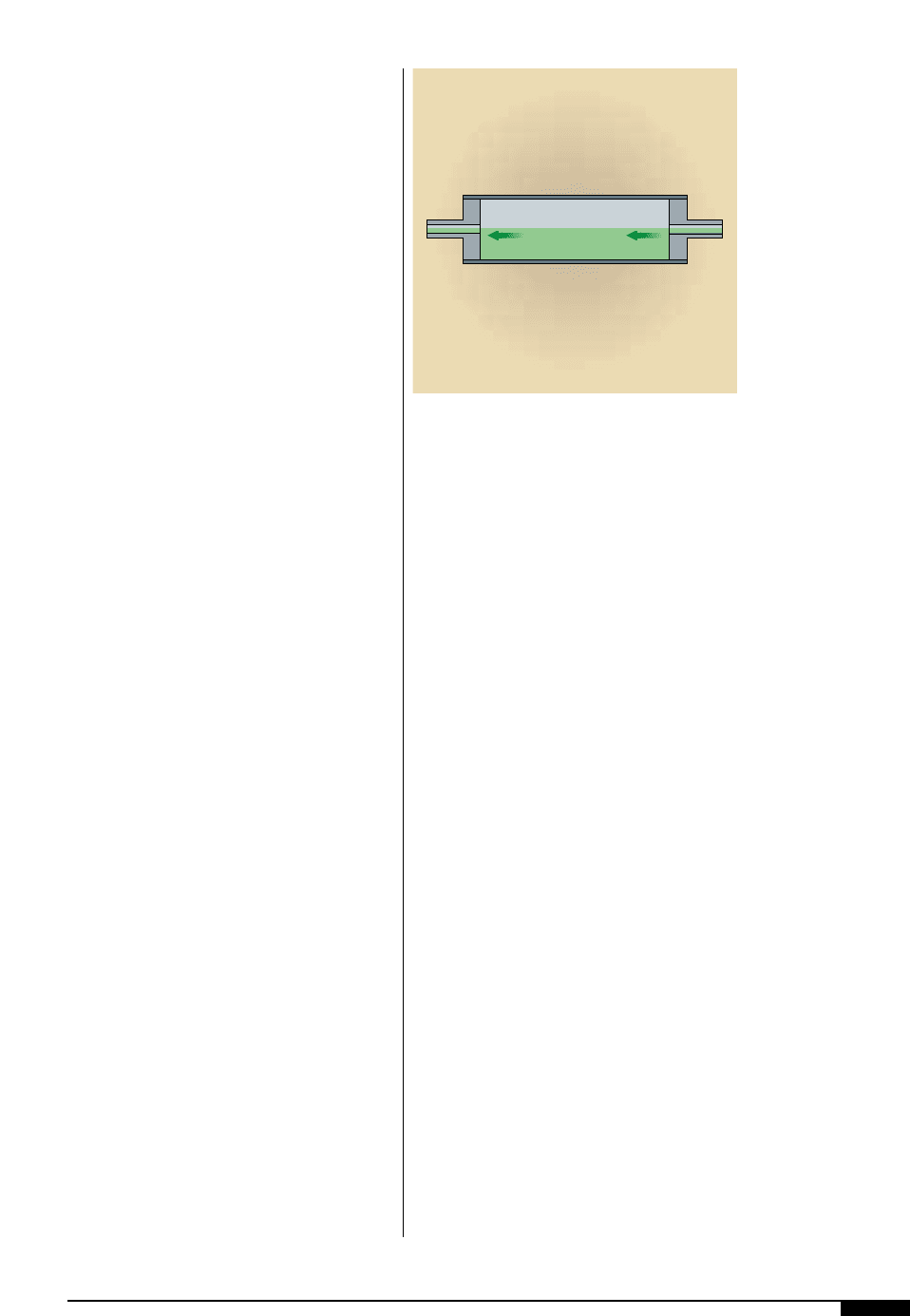
PRESSES AND PRESS EQUIPMENT 83
them to the surface of the cooling roll is pri-
marily by conduction. The heat transfer from
the surface of the cooling roll, through the
wall of the cooling roll, to the cooling medi-
um, is also by conduction.
With the ever-increasing cost of energy,
cooling-roll heat transfer efficiency will
become an ever-increasing cost problem.
Cooling-roll efficiency is equal to the roll’s
output of energy divided by the energy input.
Energy input is the heat transferred from the
substrate to the cooling-roll shell; energy out-
put is the heat transferred from the shell to
the coolant and finally carried away.
The basic heat transfer expression, without
any refinements is:
H U A T
L
Where
H = The total heat removed from the sub-
strate in British Thermal Units (BTU)
per hour.
U = Overall conductance or rate of heat
transfer of the system (BTU/hr/ft
2
/°F)
A = The area of the web in contact with
the cooling roll surface
T
L
= Log
e
mean effective temperature dif-
ference between substrate and coolant
(°F)
These heat calculations can be very com-
plex because of the many factors that affect
the heat flow:
• press speed and dryer temperature;
• mass and conductance of the web
material;
• conductance of the cooling drum mate-
rial;
• type and temperature of the coolant;
• level of smooth versus turbulent
coolant flow in the cooling drum; and
• corrosion scale on the inner wall of the
drum.
If an open coolant system is used, with the
source being the local water supply, inlet
water temperature variation in the summer
and winter must be considered, along with
the total pressure range available and the
flows required.
Understanding the expression can also
help bring about a practical balance of fac-
tors for an application. How many sub-
strates can be run? At what speeds? At what
weights and widths? For instance, where a
single roll diameter may be too large and
impractical, then two or more smaller rolls
may be more suitable and add flexibility to
an operation. For a sophisticated cooling
roll application, the only foolproof approach
is to fabricate an experimental model and
then use the experimental value obtained
to confirm theoretical value calculated.
Cooling Roll Design
If the press is small (36" or less), runs at
speeds of only 300 to 400 feet per minute,
and substrate temperature reduction needed
is minimal, a simple single-body cooling roll
may do the job. (Figure
5!
). The coolant
flows in one end, fills the roll about half full,
and flows out the opposite end. The sub-
strate must possess some strength since it
will have to withstand some roll imbalance.
If more substrate cooling is required and
imbalance must be minimized, the self-vent-
ing roll (Figure
5@
) may do the job. In this
Outlet
End
12" to 48" Face
3" to 6" Diameter
Coolant
Inlet
End
5!
5!
A typical single-body
cooling unit for small
presses, where coolant
flows in one end, fills
the roll about half way
and flows out the
opposite end.
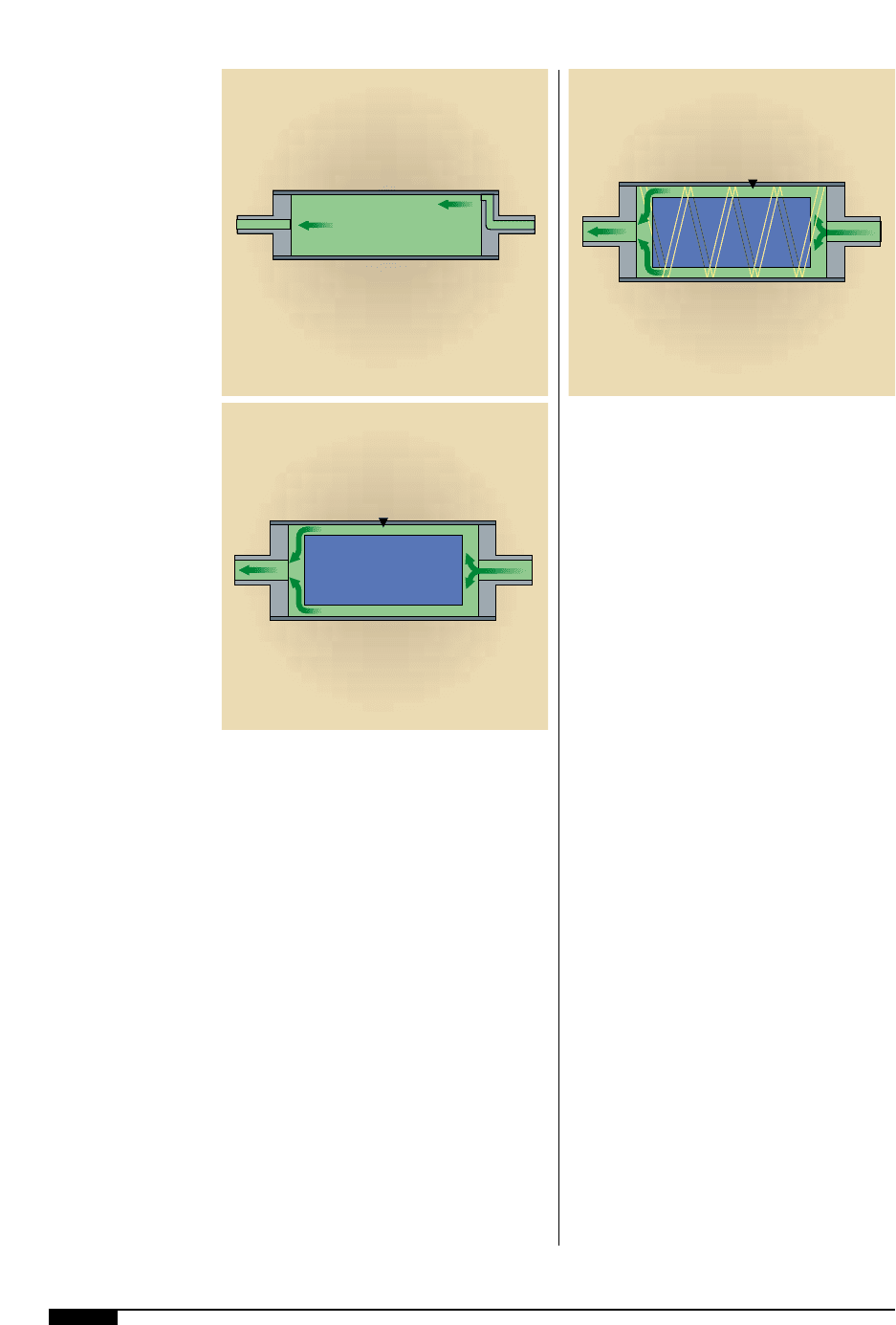
84 FLEXOGRAPHY: PRINCIPLES & PRACTICES
design, most of the air bank is automatically
exhausted as the roll rotates and most of the
roll body is in contact with the coolant.
A further improvement in substrate cool-
ing and roll efficiency is the double-bodied
roll (Figure
5#
). The coolant is forced to
flow in the annular or ringed space. Con-
sequently, more flow and velocity control
can be designed into the roll, resulting in
more heat transfer from the substrate.
Generally the flow rate will remain in the
laminar flow range and heat transfer will be
limited by that condition.
A refinement of the double-bodied cool-
ing-roll design is the addition of a spiral
wound coolant chamber (Figure
5$
). The
ideas and designs that have come out of this
refinement effort over the past few years are
many and varied. Some of these designs are
patented, which may attest to their impor-
tance in this phase of the roll business. Only
the spiral-wound version is shown and dis-
cussed. The outside diameter of the inner
body is spirally wound with an appropriate
material. When this inner body assembly is
placed into position within the outer body, a
distinct coolant passage is formed in the
annular space. This design gives accurate
control of the rate of flow and the velocity of
the coolant.
Q A V
Where :
Q = rate of flow or discharge (ft
3
/sec)
A = passage area (ft
2
)
V = coolant velocity (ft/sec)
If a single passage area is required, the
pitch or angle of the spiral is equal to the
passage width plus the width of one spiral.
If, for example, four passages are required to
handle the rate of flow, the pitch is figured as
mentioned and the lead would be four times
the pitch. With this control available, the
designer can increase the coolant velocity
and change laminar flow to turbulent flow.
Turbulent flow is desirable since it increases
heat transfer most by reducing the coolant
film and agitating, with eddy currents, the
coolant itself. In this cooling roll, using
5@
For substrates that
require more cooling, a
self-ventilating cooling
roll automatically
exhausts the air as the
roll rotates comes in
contact with the coolant.
5#
In a double-bodied
cooling roll, coolant is
forced to flow in an
annular space. The
increased flow and
velocity control promote
greater heat transfer
from the substrate.
5$
A spiral-wound
double-body cooling
roll provides a coolant
passage that allows
accurate control of the
flow rate and velocity of
the coolant.
Outlet
End
12" to 48" Face
3" to 6" Diameter
Coolant
Inlet
End
Outlet
End
12" to 240" Face
7" to 40" Diameter
Coolant
Inlet
End
Outlet
End
12" to 240" Face
7" to 40" Diameter
Coolant
Inlet
End
5#
5@
5$

PRESSES AND PRESS EQUIPMENT 85
water and water-base coolants with a range
of velocities from 11 to 15 feet per second
will generally result in turbulent flow.
Where an application requires a minimum
temperature gradient across the face of the
roll, the spirals can be mounted with a
decreasing helix angle. Continually decrea-
sing the flow area increases the coolant
velocity as its temperature is increasing and
brings about this desirable effect. As these
rolls become more efficient due to improved
design and better flow characteristics, it is
important to stay within the pressure capa-
bilities of the system. Remember that the
friction head varies in close relation to the
square of the velocity. This type of roll is usu-
ally used in a closed system along with a
treated coolant and an automatic chiller as
part of the package.
A hydrostatic or pressure test is necessary
on all of these rolls. The speed of the sub-
strate and roll will determine whether a sta-
tic or dynamic balance is required. On the
more critical cooling-roll applications, dy-
namic balancing is performed with the roll
full of coolant.
The flexographic process is growing
because it can be adapted to handle a wide
variety of packaging substrates. The heating,
drying and cooling equipment components
make up a very important segment in this
process. The cooling roll is also being adapt-
ed so it too can handle a wider variety of
substrates.
STATIC ELECTRICITY
Whenever nonconductive materials touch
or rub against one another, a charge of static
electricity may be generated. This electrosta-
tic charge attracts dust particles, causes
materials to cling to each other and can cause
mild to violent electric shocks.
What is static electricity and how do we get
rid of it, or at least control it? When the phe-
nomenon is understood and controlled, the
principles can be harnessed to provide advan-
tages for the printer, such as substrate clean-
ing, film surface treatment and dust control.
Causes of Static
Static electricity is generated by unbalanc-
ing the molecular construction of relatively
nonconductive materials such as plastics
and paper. All matter is composed of single
elementary atoms, or groups of atoms called
molecules. An atom consists of a nucleus
surrounded by one, or many, orbiting elec-
trons, which have a negative charge. The
nucleus consists of positively charged parti-
cles (protons) and neutral particles (neu-
trons). Atoms are most stable when they are
electrically neutral and carry no charge. An
atom in this state requires the number of
orbiting electrons and protons to be equal.
In certain complex molecules, the forces
between the protons and outer electrons are
very weak and electrons may be easily
removed. The loss of any electrons causes
such molecules to become positively
charged, because the number of protons
exceeds the number of electrons. Conversely,
nuclei of certain atoms exert very strong
forces on their electrons and on others in
close proximity. As a result, these nuclei pick
up additional electrons and become charged
negatively because the number of electrons
now exceeds the number of protons. This
exchange of electrons may simply be caused
by contact with a dissimilar material.
The ability of a material to surrender its
electrons or absorb excess electrons is pure-
ly a function of the conductivity of the mate-
rial. For example, in a pure conductor, such
as copper, the molecules offer little resis-
tance to the flow of electrons and any charge
imbalance within the material is soon dissi-
pated. However, in the semiconductor range
of materials, such as some bond papers, the
ability of the atoms to surrender their elec-
trons is relatively high and can be accom-
plished by friction, heat or pressure. With

purely nonconductive materials, such as
plastics, it is extremely easy to disrupt the
molecular construction, causing the material
to charge with the slightest friction, heat or
pressure and, because the material is non-
conductive, the charge remains static.
Static electricity has as its basis an imbal-
ance of electrons in a material. Instead of the
material being electrically neutral in its nor-
mal state, it has either a positive or negative
charge. In other words, the atoms or mole-
cules on its surface have either gained or
lost electrons. The number of electrons that
have been added or removed from a materi-
al’s surface determines the magnitude of the
static charge.
To achieve electrical neutrality, a charged
material exerts a force on other adjacent
materials. This force is known as an electro-
static field. As is the case with magnets, sim-
ilarly charged materials repel each other,
whereas oppositely charged materials
attract each other.
Controlling Static
Three basic methods for controlling static
electricity are:
• antistatic conductive coatings, additives
or sprays;
• grounding of the charged material; and
• cyclic ionization of the air surrounding
the charged material.
Anti-static Coatings. If the surface conductivi-
ty of the processed material can be raised,
then preventing static electricity becomes rel-
atively easy. For example, adding surface
conductivity to plastics will move them up
into the higher conductivity range and pre-
vent the build-up of static electricity that is
caused by friction. This is normally accom-
plished by the use of additives such as mois-
ture and antistatic sprays. The average anti-
static spray is made from a soap-based mate-
rial that has been diluted in a solvent, such as
mild alcohol. A fire retardant is added to com-
bat flammability of the solvent, then pressur-
ized gases are added to form an aerosol can of
antistatic spray. As this spray leaves the noz-
zle of the aerosol can, the propulsion gases,
fire retardant and solvents evaporate a short
time after contact with the nonconductive
material, leaving a conductive coating on the
surface of the material. As long as this coating
is not disturbed, it will be difficult to generate
static electricity in this material.
Grounding. The simplest and oldest method
of removing or neutralizing static electricity
is by a combination of induced ionization
and grounding. These nonpowered (or pas-
sive) systems use conductive bristles placed
in close proximity to the charged material,
inducing an electrostatic field between the
bristle tips and the material. The electrostat-
ic field ionizes the air, which in turn neutral-
izes the static charge on the material.
Such passive devices are relatively inex-
pensive. However, if the static charge is not
sufficiently high, or the bristle tips not suffi-
ciently conductive, the electrostatic field
between the bristle tips and the material
may not form, in which case ionization of the
air cannot occur and the static charge will
not be neutralized.
Tinsel is the most common tool for this
application. However, tinsel is often misused
and, therefore, not successful. For a passive
induction device to be effective, the follow-
ing conditions must be met:
• the tinsel must have a metal core to be
conductive;
• the tinsel must be well-grounded elec-
trically;
• the tinsel must be within 0.25”
(6 mm) of the material to be neutral-
ized; and
• there must be “free air space” under
the material to be neutralized.
In this fashion the tinsel can reduce static
electricity on both sides of the static-laden
material.
86 FLEXOGRAPHY: PRINCIPLES & PRACTICES

PRESSES AND PRESS EQUIPMENT 87
It must be recognized that any passive
induction device, such as tinsel, will never
reduce or neutralize static electricity to the
zero potential level. This limitation is due to
the fact that a threshold or beginning voltage
differential is needed to “start” the process.
Operator Grounding. It is also possible to dis-
turb the molecular construction of the
human body. As strange as this sounds, if an
operator is isolated by standing on a wooden
floor or wearing crepe rubber-soled shoes,
he or she will soon pick up a static charge,
which will create a voltage difference above
ground (zero) voltage. It is possible for an
operator to gain a charge of several hundred
volts each time he or she handles a piece of
charged plastic. As the operator handles
many different pieces, he or she may
become charged to a sufficient voltage to
cause a flashover. The operator may receive
a mild to severe shock, or damage a static-
sensitive device.
This build up of static potential can be pre-
vented by having the operator stand on a
grounded conductive mat or by the use of
commercially available personnel grounding
equipment. Personnel grounding equipment
is important if operators are sitting while
working. Sitting is the best means of isolat-
ing an operator from grounded conductivity;
making them extremely vulnerable to static
discharge.
Machine Grounding. In addition to personnel
grounding equipment, grounding all plant
machinery and related equipment is most
important. Besides the safety factor, a well-
grounded machine will help drain off
extremely high charges of static electricity
from partial conductors. Remember, ground-
ing is only an aid to reducing problems with
static electricity; it is not a solution.
Powered Static Eliminators. Static elimina-
tors are ionizing units that produce both pos-
itive and negative ions. The unbalanced
material attracts the ions so that neutraliza-
tion occurs.
Most powered static neutralizers ionize
the air by placing a high, alternating voltage
(4,000–8,000 volts) on sharp points, in close
proximity to a grounded shield or casing. As
the high-voltage, alternating potential pulses
through the 60-cycle-per-second operation,
the air passing between the sharp points and
the grounded casing is ionized, generating
both positive and negative ions. Since the
United States operates on a 60 cycles per
second voltage, the polarity of the ionization
changes every 1/120 of a second.
Cyclic air ionization is the most widely
used method of static control. It involves
removal of electrons from air molecules, cre-
ating positively charged cations and, con-
versely, adding electrons to form negatively
charged molecules called anions. If the mate-
rial being neutralized is positively charged, it
will immediately attract negative anions from
the static neutralizer, absorbing their free
electrons, while repelling the positive ions.
Conversely, if the material being neutralized
is negatively charged, it will attract the posi-
tive ions and give up the spare electrons,
while repelling the negative ions. When the
material becomes neutralized, there is no
longer an electrostatic attraction and the
material will cease to absorb ions.
An outside source of AC power is used to
operate an ionizing unit. Such systems are
very efficient and can be operated at moder-
ate cost with a long life expectancy.
Radioactive Isotopes. Nuclear-powered equip-
ment may also be used to generate ionized
air for static neutralization. These devices,
powered by Polonium 210 isotopes, which
have a half-life of only 138 days, continually
lose their strength and must be replaced
annually. They are more expensive and less
effective than electrically powered devices.
These nuclear devices cannot be purchased
and are leased by users. One-year lease costs
are usually more than the purchase price of
comparable electrically powered devices.

CONCLUSION
In order to solve problems related to stat-
ic electricity, certain basic steps must be
taken. The logical approach is to identify the
problem; determine the solution; and then
select the proper equipment to solve the
problem.
To identify the problem, some sort of mea-
suring equipment must be used. For exam-
ple, an electrostatic locator will measure the
amount of static electricity that is present
and identify the polarity as either positive or
negative. Measuring and locating static elec-
tricity will remove the mystery often related
to this phenomenon.
Once the problem is identified, the solu-
tion should be considered next. Can the sta-
tic electricity be controlled by grounding,
induction, ionization or a combination there-
of? In making this decision, keep in mind the
facts mentioned relative to conductivity.
With pure conductors or partial conductors
(such as the human body or some paper),
grounding should be considered. However, if
working with insulators, such as plastics,
ionization must be added.
Choosing Equipment
The most effective neutralizing equipment
is electrically powered. If powered devices
are located where employees may come in
contact with them, they should be mechani-
cally shockproofed to prevent contact with
the “hot” ionizing points.
For explosion-prone environments, explo-
sion-proof induction-type neutralizing equip-
ment should be chosen. Also, a number of
specialized pieces of equipment are avail-
able to the electronic industry to provide sta-
tic-free work areas.
By following the above steps, the risks of
building up dangerously high charges of stat-
ic electricity can be greatly reduced. It is
important to understand that static electrici-
ty cannot be entirely eliminated. In fact, the
term “static eliminator” is definitely mislead-
ing. For example, a charged piece of materi-
al can be neutralized by utilizing a static elim-
inator. However, it does not eliminate static
electricity because, if friction is applied to
the material after being neutralized, static
electricity will again be generated.
88 FLEXOGRAPHY: PRINCIPLES & PRACTICES
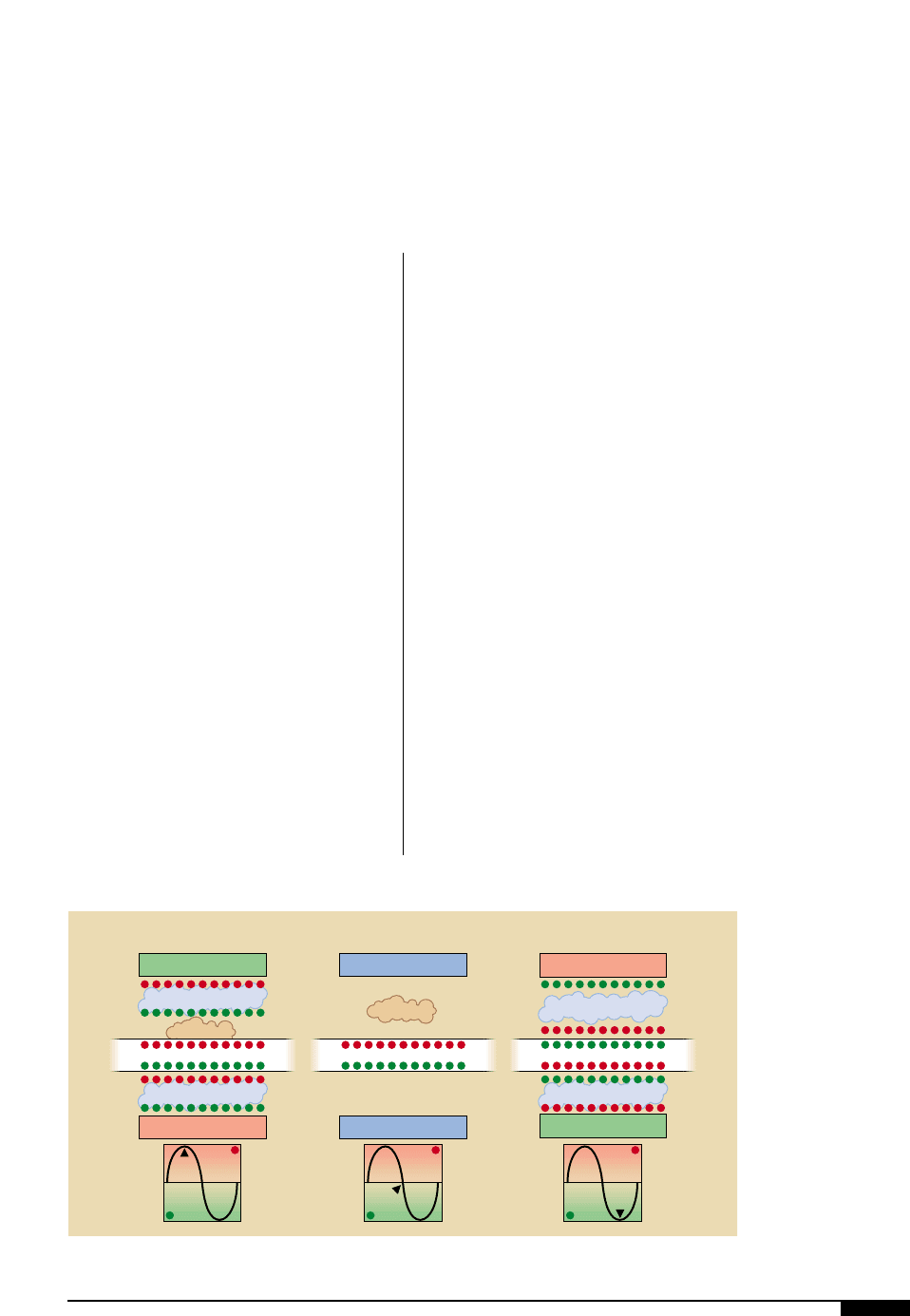
PRESSES AND PRESS EQUIPMENT 89
Substrate Cleaning
D
ust is by far the biggest enemy
of quality printing, especially
in polymer film, paper or cor-
rugated processing operations,
and therefore must be ad-
dressed by press builders and
converters alike.
No dust removal system is absolutely per-
fect. However, if the problem is addressed at
its source, i.e., immediately where dust and
electrostatic charges are produced, it can be
controlled, yielding higher production and
quality. The most effective system for remov-
ing dust from a substrate prior to printing
uses the electrostatic repulsion principle as
explained in the preceding section.
The most advanced ionic cleaning systems
involve a corona field formed between two
oppositely charged electrodes in a quartz
enclosure. The substrate to be cleaned is
passed through this corona field, which is
generated using an alternating high voltage
(15,000 volts) at high frequency (5,000–7,000
cycles/sec).
At peak voltage a corona field is built up
between the two electrodes (+/–) and every-
thing within the corona field (air, substrate,
dust) becomes conductive. When this hap-
pens, electrons begin to flow between the
two electrodes. As the substrate is passed
between the electrodes, the surface of the
substrate is charged positively on the side
facing the negative electrode and is charged
negatively on the side facing the positive
electrode. Any dust particles on the surface
of the substrate will also be charged in a sim-
ilar fashion Figure
5%
.
As the polarity of the electrodes change,
the corona field breaks down. The air
between the surface of the substrate and the
adjacent electrode functions as insulation.
Powerful electrostatic fields are formed,
which are charged positive above the sheet
to be cleaned and negative on the underside.
The dust particles now show an opposite
polar charge, are repelled by the substrate,
float into the positive field and are sucked
away by a fan.
+ + + + + + + + + + +
– – – – – – – – – – –
+ + + + + + + + + + +
– – – – – – – – – – –
+ + + + + + + + + + +
– – – – – – – – – – –
–
+ + + + + + + + + + +
– – – – – – – – – – –
–
+ + + + + + + + + + +
– – – – – – – – – – –
–
+ + + + + + + + + + +
– – – – – – – – – – –
+ + + + + + + + + + +
– – – – – – – – – – –
+
+
+
- - - Electrode - - -
Substrate
Ionized Air
Ionized Air
+ + Dust + +
1
+ + + Electrode + + +
- - - Electrode - - -
Substrate
Ionized Air
Ionized Air
3
+ + + Electrode + + +
0v Electrode 0v
Substrate
+ + Dust + +
2
0v Electrode 0v
5%
5%
In electrostatic cleaning,
as the substrate is
passed between the
electrodes, the surface
of the substrate as well
as the dust particles are
charged (positively on
the side facing the
negative electrode,
negatively on the side
facing the positive
electrode.) This causes
dust particles having an
opposite charge to be
repelled and sucked
away by a fan.

90 FLEXOGRAPHY: PRINCIPLES & PRACTICES
After reversing the polarity of the elec-
trodes, the corona field forms again as soon
as maximum current is reached. With the
repeated polarity change and subsequent
breakdown of the corona field, the cleaning
process takes place again. Each change of
polarity, which occurs upwards of 10,000
times per second, results in a cleaning action.
FILM TREATING
A number of the flexible packaging materi-
als, particularly polyethylene and polypropy-
lene, need to be treated prior to subsequent
printing or coating operations in order to
make them more wettable, that is, more
receptive to accepting printing inks, coating
and adhesives. Corona discharge treating of
the substrate is one means of making the sur-
face more polar, hence more wettable.
Corona Discharge
Corona discharge is a unique means of
applying a concentrated electrical discharge
to the surface of a moving web. It is accom-
plished by passing a moving web over a spe-
cial dielectric-covered treating roll and apply-
ing a source of high voltage, high frequency
power to an electrode properly spaced over
the surface of the traveling web. The resultant
voltage gradient breaks down the air into a
gaseous conductor, and the corona and ozone
that are generated make the substrate surface
more polar, and more wettable.
Typical Film Treating Applications
Film treating stations are specially designed
and engineered enclosures that house the
treating electrode and roll assemblies. They
have access doors for web threading and rou-
tine servicing, inspection windows to observe
corona discharge and hoods, and extraction
ports for ozone removal. Each station is tai-
lored to the particular application and sized to
match line speed and web width. Stations can
be specified to treat one or both sides of the
web. Station enclosures are normally of a
steel frame and panel construction. Ferrous
parts are primed and finish-coated with corro-
sion-resistant paint. Access doors have
Plexiglas inspection windows. The doors are
electrically interlocked to prevent corona dis-
charge from operating when opened. Ozone
exhaust openings are normally located and
cut to size at the installation site, but this can
also be done during fabrication of the unit.
Electrodes are wired to a porcelain high-
voltage insulator. Stations have pneumatical-
ly actuated electrode assemblies, interlocked
to prevent treating operation when the elec-
trode assembly is retracted. Treating rolls are
equipped with adjustable electronic zero-
speed control switches to prevent treating
operation unless the roll is turning.
Foil and Conductive Substrates. Foil and con-
ductive substrate-treating stations may be
single-sided or double-sided stations, with
hard chromium-plated ground rolls and
dielectric-covered rotating electrode rolls.
They will treat web widths up to 100" at line
speeds up to 1,000 fpm (Figure
5^
).
Split-Box Film Treating Station. These sta-
tions have drop through automatic web
thread-up and single- or double-sided sta-
tions for treating variable-width substrates.
They are usually available with 4" diameter
rolls and will treat web widths up to 98" at
speeds up to 250 fpm. (Figure
5&
).
Adjustable Shoe Electrode Station. These sta-
tions are also single- and double-sided. They
treat variable widths up to 144" at line
speeds up to 1,500 fpm. They are usually
available with 6" to 24" diameter rolls
(Figure
5*
).
Pressurized Film-Treating Station. Specially
engineered, the pressurized film-treating sta-
tion has single- and double-sided stations for
operation in hazardous atmospheres. It can
be obtained with a pressurized treating sta-
tion and high voltage transformer enclosure
and with a pressurized remote-control sta-
tion (Figure
5(
).
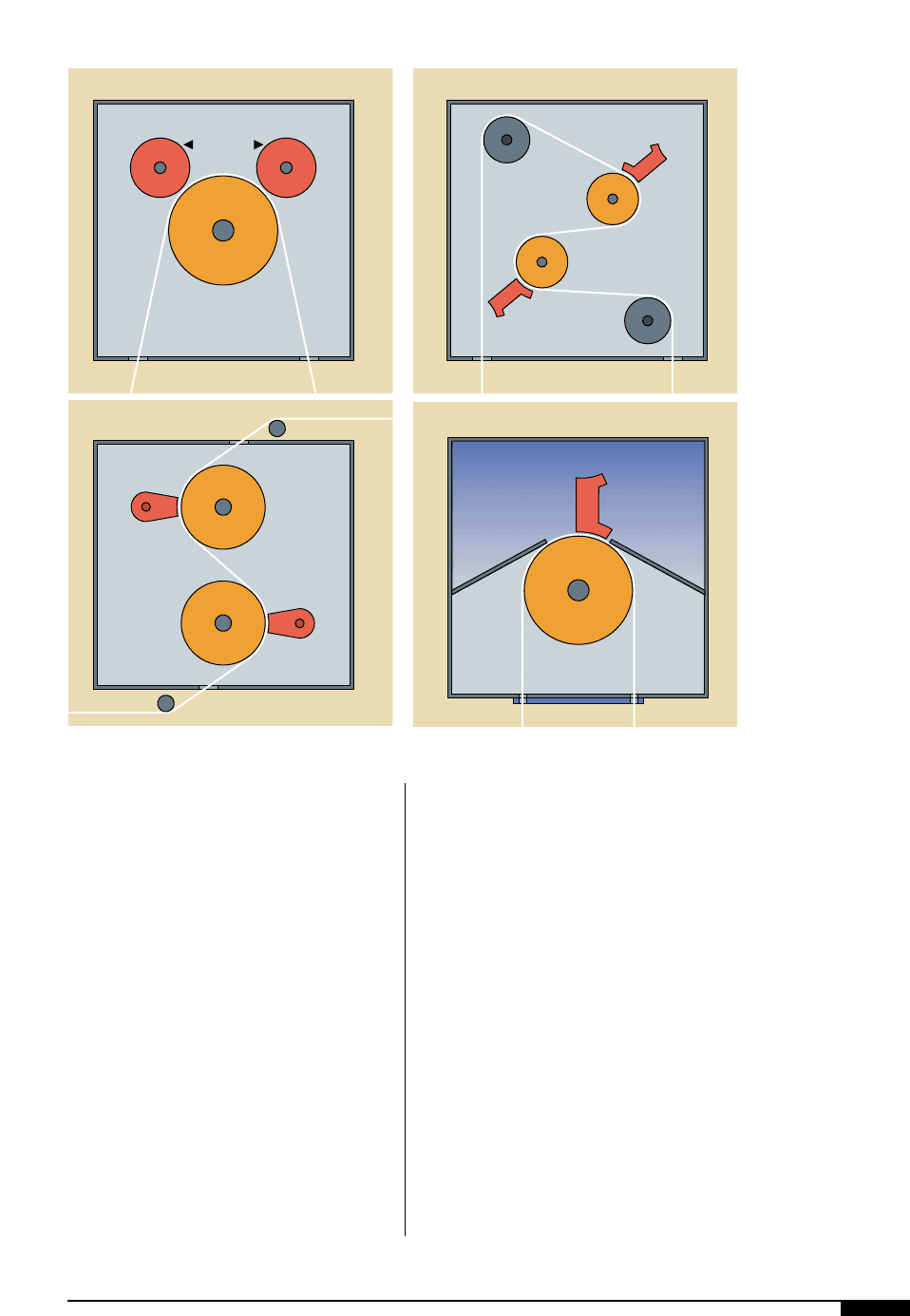
PRESSES AND PRESS EQUIPMENT 91
POWDER SPRAY SYSTEMS
Powder spray systems are used to evenly
distribute micron-sized particles onto the
surface of the moving web. The particle
material may be starch, to promote ink dry-
ing or to prevent ink offset and blocking in
the rewound roll; or in a laminating process,
it may be a heat-set powder adhesive. The
system uses the principles of electrostatic
attraction and repulsion to control the distri-
bution of the particles.
Electrostatic Powder Spray
The electrostatic system feeds the micron-
sized dry powder particles from a hopper to
the surface of a micro-etched chromium
plated roll. The rotating speed of the roll
controls the feed rate of the particles. The
particles adhere to the surface of the roll
until they enter an electrostatic field created
by a high voltage discharge tube, at which
point they become ionized. The web, passing
in close proximity, is charged with the oppo-
site polarity to the powder particles, thereby
attracting them. The electrostatic dispersal
of the particles tends to space them very
evenly over the surface of the web, which
eliminates pyramiding and with the electro-
static bond, prevents particle drifting.
Dust Control
Within the electrostatic spray unit there
are twin air curtains to envelop the spray
and prevent excess floating powder.
Downstream of the coating station is an
extraction hood to collect any particles that
Rotating
Electrode
Web
Roll Type
Electrodes
Adjustable
Shoe
Electrode
Rotating
Electrode
Rotating
Electrode
Web
Adjustable
Shoe
Electrode
Idle
Roll
Idle
Roll
5^ 5*
Rotating
Electrode
Rotating
Electrode
Web
Shoe Type
Electrode
Shoe Type
Electrode
Idle Roll
Idle Roll
Rotating
Electrode
Web
Adjustable
Shoe
Electrode
5&
5(
5^
A foil and conductive
substrate-treating
station may be single-
or double-sided, and is
capable of handling
webs widths up to 100"
at line speeds up to
1,000 fpm.
5&
A split box film-treating
station treats variable
width substrates.
5*
Adjustable-shoe
electrode stations may
be single- or double-
sided stations capable
of handling widths up
to 144".
5(
Pressurized film-
treating stations are
specially engineered for
hazardous atmospheres.
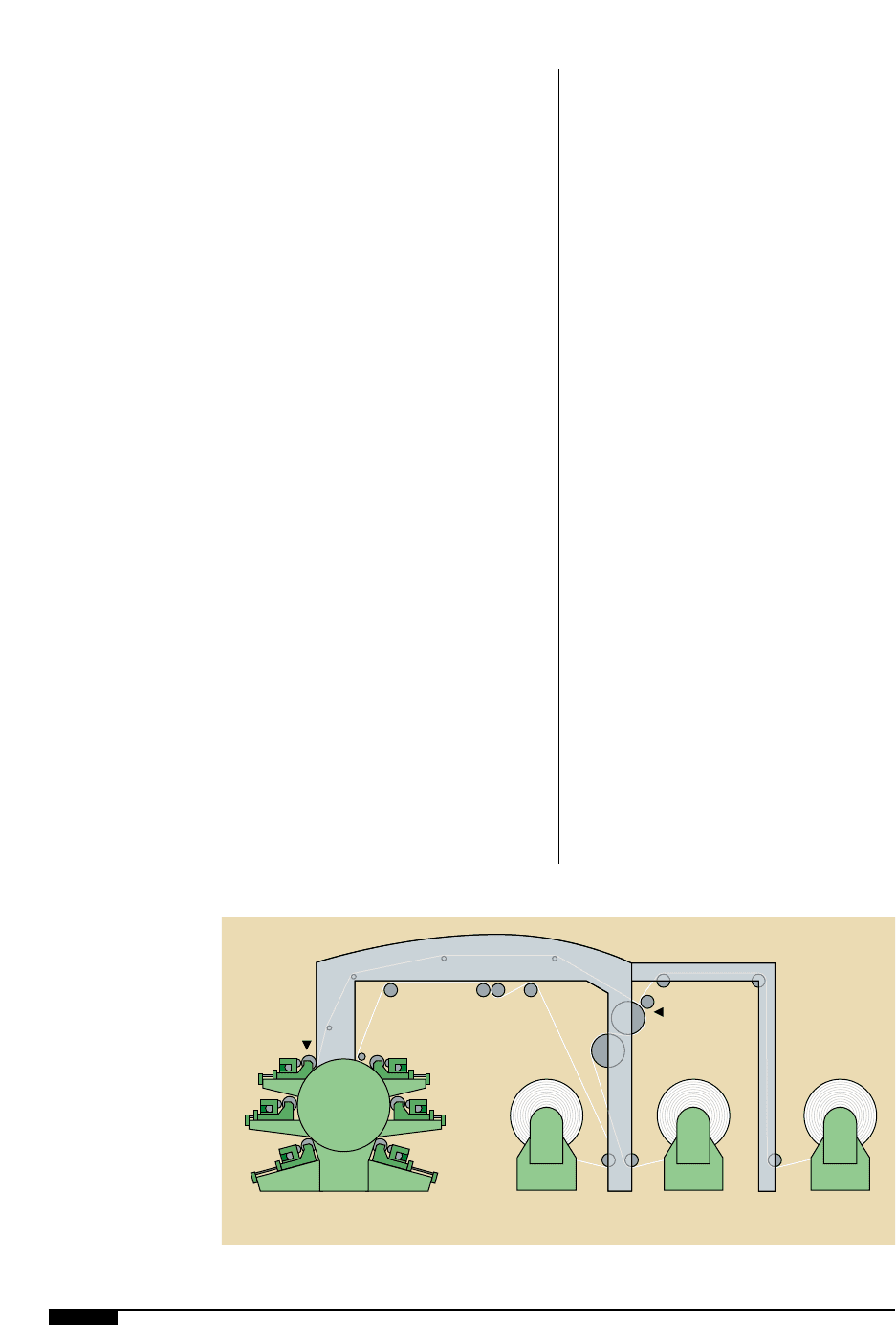
6)
This six-color central
inpression press has
been modified for
laminating after
printing.
92 FLEXOGRAPHY: PRINCIPLES & PRACTICES
may become airborne. These particles are
drawn to vacuum plenums on each side of
the hood and transported to a collection fil-
ter bag. The dusting ability of the electrosta-
tic sprayer is not affected and the system
helps to assure a cleaner press and cleaner
plant air.
IN-LINE LAMINATING
Film laminating has had a growth curve
parallel to flexography in flexible packaging
and has usually been performed by convert-
ers who were already flexographic printers.
Competition forced converters who did not
have the capital or market volume for sepa-
rate out-of-line techniques to adapt existing
presses to include a lamination section.
The first development in this modification
was to add a thermal combine (heat and pres-
sure) unit to the exit end of the press and
combine two Saran-coated cellophane webs.
As more types of film entered the flexible
packaging field, and as increased production
speeds became necessary, solvent-based
adhesives were used for film laminations,
both in-line and off-line. For in-line opera-
tions, the adhesives were applied by the last
printing station of the press, then dried in the
drying tunnel before being combined with the
second web.
Modified Press for Laminating
Figure
6)
shows a six-color flexo press
modified for in-line laminations. This arrange-
ment has the disadvantage of slow speed
operation. In order to eliminate ink blistering,
it is necessary to slow the press to speeds that
allow all the ink to dry before applying the
adhesive in the last printing station.
Should the converter wish to modify an
existing press so that in-line laminations can
be performed, there are a number of steps
that must be taken. They will be addressed in
the following four sections.
Space. Approximately 12" of space at the
rewind end of the press is necessary to pro-
vide for installing the second unwind stand.
The unwind can be any suitable type, but it is
preferable for it to be the same as the exist-
ing unwind. This match-up permits running
roll-for-roll at both unwinds and minimizing
mid roll splices in the laminated material.
Structure. An overhead structure with idler
rolls is required to transport the web from the
second unwind to the laminating nip. Since the
web passes above the rewind, the structure
must be high enough so as not to interfere with
the personnel servicing the rewind or with the
rotation of the rewind if it is the turret type.
The idlers should be spaced not more than 4'
apart and preferably grooved to prevent air
from getting between the web and idler rolls.
Laminator
Lamination
Unwind
Print and
Lamination
Rewind
Stock
Unwind
Central Impression
Press
Adhesive
Applicator
6)
